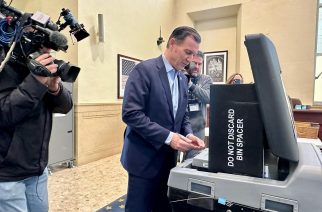
Assembly Republicans unveiled a bill that would require member items, discretionary funds, and so-called “lump sum payments” — typically controlled by legislative leaders and the governor, and negotiated behind closed doors — be made public and fully transparent in the state budget for rank-and-file legislators, the public and the media to review.
Assemblyman Jim Tedisco, R-Glenville, is sponsoring the “Truth in Spending” bill, which he says has the support of 40 sponsors so far. It would require the executive and legislature to fully disclose how any public funds they allocate are spent and where the money comes from. The bill has the support of many of Albany’s government watchdog groups.
The bill was inspired by a new report called “Spending in the Shadows” by Citizens Union, which found “$2.4 billion in opaque funds in 80 ‘lump sum’ pots in the state budget,” which allow spending decisions to be made by the governor and legislative leaders without adequate transparency, scrutiny or review after the budget has passed.
Dick Dadey, executive director of Citizens Union, and Tim Hoefer, executive director of the Empire Center, were present at the bill’s unveiling in Albany to show support. Barbara Bartoletti, from the League of Women Voters, and Blair Horner, from NYPIRG, also are offering their support for Tedisco’s efforts.
The “Truth in Spending” bill, which has not been assigned a bill number as of press time, is in part a response to the numerous public corruption scandals that have rocked the state Capitol in recent months and years.
“The taxpayer’s dollars and the state budget are not the leader’s own personal piggy bank,” Tedisco said. “This [bill] is the hammer to smash open that piggy bank and act as a magnifying glass to create total transparency to see where the money comes from as allocated in the state budget and how it’s being spent.
Specifically, the Truth in Spending Bill would require:
- All legislative earmarks be used only for a public purpose and be clearly outlined within the state budget for members, the public and media to review at least three days before being voted on.
- Notification before the budget is passed and after the funds are distributed, detailing the purpose of the earmarks, who will receive the money, and which legislative districts are impacted.
- The governor and legislators to sign sworn conflict-of-interest disclosure forms before any recipient receives state funds. The forms would require disclosure of all political donations received within the past five years from the person or group scheduled to receive the state funding.
- Recipients of the state funding must attest under penalty of perjury that their organization actually spent such funds in the manner and for all the purposes designated in the application for allocation.
- Publicly posting spending allocations, signed disclosure forms, memorandums of understanding and contracts online in an easy to read and analyze format on both the state Comptroller’s website and the Assembly and Senate websites.
- Recipients seeking state funds must be certified as tax-exempt, nonprofit organizations under section 501 (C) (3) of the Internal Revenue Code in New York state; a state agency; a municipality or their affiliated department; or university, college, or school district, and are not in bankruptcy or arrears on any state obligations.
“The Truth in Spending Act is another example of the growing rank-and-file chorus for reform in Albany,” said Blair Horner, executive director of the New York Public Interest Research Group. “Taxpayers deserve a strict accounting of how their money gets spent and the assemblyman’s proposal properly focuses on too hidden state spending. We hope this legislation triggers a debate over the need for greater budget transparency.”









